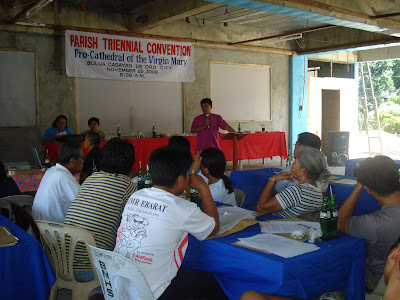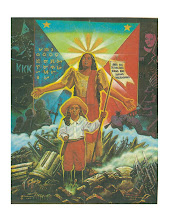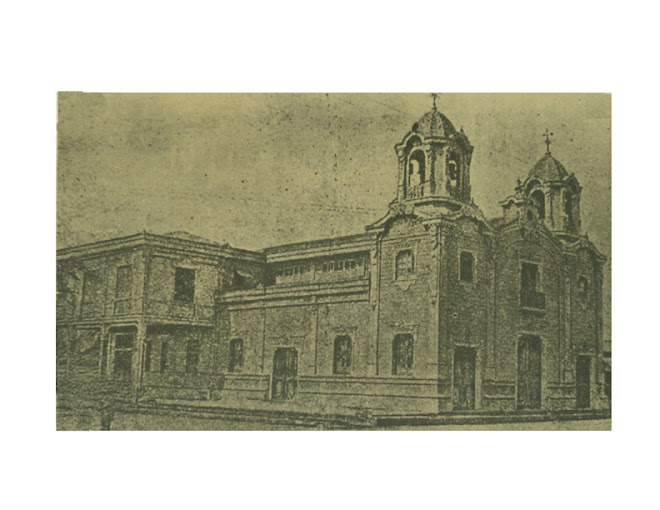Clergy Family as Part of God’s Household
(1 John 3:1-3)
(Gi-andam ni Rev. Fr. Vic Arellano alang sa gipahigayong Consultation on IFI Clergy’s Children Organizing Program, October 2-4, 2008, Cathedral Church, Davao City)
Introduction:
Maayong hapon sa tanan! Gihatagan ko ug tahas nga mohatag ug BTR, akong panghinaut nga ang mensahi sa maong teksto maghagit kanato sa paghimo ug mga buluhaton isip pamilya ug pari ilabina diha sa hisgutanan sa pagtukod ug usa ka maayong katilingban diin ang mga anak sa Dios anaay pagminahal, pagtinabangay ug panaghiusa matag usa.
Ang tagsulat naga-emphasize nga pinaagi sa atong pagka-pamilya diha kang Kristo, ingon nga Siya anak sa Dios, kita usab “paganganlan nga mga anak sa Dios”. Kini nag-gumikan tungod sa dakong gugma sa sa Dios nga gihatag niya ang iyang bugtong anak nga si Hesukristo (Juan 3:16).
Context:
Kini nga sulat o epistola nagpaambit sa mao ra nga estilo, hugpong sa mga pulong, ug sinultihan nga kapareho sa ebanghelyo ni San Juan. Nagpasabot nga kining duha (Gospel of John and Epistle of 1st John) gisulat sa mao rang tawhana. Ang tumong ug tinguha niini ma-o ang pagpakig-batok sa pagtulon-ang supak sa pagtoo, nga naghisgut nga ang espirito maayo apan ang lawas o materyal daotan.
Ang katilingbang kristohanon nianang panahona nakasinati ug tension gumikan sa cultural ug political forces, adunay internal conflicts nga nahitabo. Kini tungod kay dili sila magkasabot sa daghang mga basic issues. Usa niini, kon kinsa ang mag-set sa rules for Christian behavior, ug kinsa ang magpatuman niini para kanila. Unsay buhaton niadtong mga tawo nga nahukman na on grounds of faith (heretic). Ang hinungdan niini nga pagbahin-bahin ma-o ang kakulangan sa specific doctrinal or ethical norms.
Kini nga sulat usa ka pastoral letter, ug kini gi-address sa tanang kasimbahanan. Ang iyang concerns nag-sentro sa duha ka butang. Una, ang moral nga kahimtang sa katilingban, ang ikaduha, ang reaction sa pagka-siak sa grupo. Nabahin sa duha ka pondok ang mga kristyanos, ang usa ka pondok tinuod o mga matarong ug ang lain nga pondok, dili tinuod, sa laktod nga pagka-sulti, mga daotan.
Sagad nag-refer si Juan sa iyang naminaw o magbabasa ingon nga mga “anak” ug nag-gamit sa idea nga “brother” “igsoon” aron sa pag-emphasize sa klasi sa pag-amuma ug gugma nga maitunol ngadto sa uban diha sa katilingbang kristohanon (adelphos = interpreted “brother and sister” in the Revised Standard Version).
Siya nag-gamit sa konsepto sa Greco-Roman image ingon nga ang mga anak sumpay sa kinaiya sa ilang amahan. Nga ang mga anak adunay kapareho nga pagkamao sa ilang amahan, ug nga sila magpadayag sa usa ka kinaiya nga nagtimaan o nagpaila sa ilang sinugdanan o gigikanan. Samtang atong makita kini nga idea sa ubang sinulat sa New Testament, si Juan kanunay nag-gamit niini nga konsepto sa iyang mga sulat ingon nga maoy iyang Central theme. Kini tungod sa iyang pagpanalipod ug pagtabang sa Simbahan nga ma-preserve ang iyang identity, faithfulness, ang Iyang kausahan, diha sa panahon sa dakong pagsulay ug paglutos.
Ang Panimalay diha sa Bibliya
Ang panimalay diha sa bibliya naglangkob kini sa dagway sa usa ka pamilya ug dapit usab sa negosyo o patigayon. Ang mga sakop sa pamilya, ang mga trabahante, ug ang mga ulipon nagapuyo sa usa ra ka balay, diin naga-lihok kini ingon nga usa ka dapit nga pinuy-anan ug dapit usab sa patigayon o negosyo. Ang mga ulipon sakop usab nianang panimalaya, gani aduna silay katungod nga makapanunod sa mga katigayonan niini (see Luke 20:9-16). Ang pangulo sa panimalay ginganla’g paterfamilias, aduna siya’y obligasyon sa mga sulogoon sa pag-provide kanila ug lawak katulganan apil na ang pagpakaon ug ang ilang siguridad (Roman household was headed by a paterfamilias or head of household).
Kon atong sabton ang panimalay diha sa Balaang kasulatan nga pagtan-aw, kinahanglan atong masabtan nga wala pa kanang gitawag nga residential district, household appliances, mayordoma, mayordomo, o sulogoon sa panimalay. Ang panimalay usa ka pamilya ug usa usab ka dapit sa negosyo o patigayon, ug nag-apil na niini ang mga sakop sa pamilya, mga ulipon, mga hardeniro, mga kusinero, clerk, mga serbidora, salesman, housekeeper, accountant, abugado, ug ang tanan nga nagpuyo nianang panimalaya (unsa ka dako nga panimalay!).
Ang matag panimalay adunay pangulo nga gitawag ug paterfamilias, ug ang tanang sakop nianang panimalaya adunay tagsa-tagsa ka bulohaton ug gihatagan silag kagahum sa paterfamilias (pangulo sa panimalay) sa pagdala o pagpadagan sa ilang negosyo. Ang negosyo o patigayon nila kasagara agriculture o panguma, maong diha sa bibliya makita ug mabasa nato kanang mga kaparasan nga kanunay mahisgutan ilabina diha sa mga sambingay ni Hesukristo.
Sa samang paagi usab, kon maghisgot ta ug panimalay sa Dios (Household of God), ang nagpuyo nag-apil na niini ang mga sakop sa pamilya (ug ang iyang mga sakop mao ang Father, Son, and Holy Spirit), ang mga angheles, ang mga kerubinis, ang mga propeta, ang mga apostoles, ug ang tanang magtotoo, kinsa gisagop ingon nga mga anak sa Dios tungod sa bunyag nga ilang nadawat.
Ang pamilya sa Dios
In the biblical concept ang pamilya sa Dios, sumala sa atong giingon, mao ang Father, Son, and Holy Spirit, ang mga anghel, ang mga propeta, ug ang mga apostoles ilang mga ulipon, and the rest of us nahisama sa mga kahayupan sa uma, in fact, si Hesus nagtawag kanato ingon nga iyang mga karnero.
Sa unang kapitulo sa libro sa Genesis, ang tawo gibuhat to be in full fellowship with God, apan tungod sa pagsupil (disobedience) ni adan, ang tawo nahimulag sa sabakan sa iyang Dios, ug naputol ang hikot nga nagbugkos sa relasyon tali sa Dios ug sa tawo.
Ato lang ipa-klaro nga adunay kalainan tali kanato ug kang Hesukristo, tungod kay kita mga binuhat lamang sa Dios, samtang si Hesus mao ang Dios mismo, incarnate as a human being. Apan tungod sa iyang dili matukib nga kalooy ug gugma, Siya nahimong tawo sama nato aron luwason ang tawo gikan sa iyang mapait nga kahimtang tungod sa iyang pagka makasasala. Kini iyang gibuhat pinaagi sa pagtugyan sa iyang kaugalingon diha sa krus aron nga ang damage nga nabuhat sa atong mga katigulangan ma-repair.
Apan dili lang kay ang pagluwas ra ang iyang gibuhat, iya pa gyud nga gipahitaas ang tawo gikan sa iyang ubos nga kahimtang pinaagi sa pagsagop kaniya ingon nga mahimong iyang mga anak. Matud pa sa sulat ni San Pablo sa taga Efeso;
“Kamo karon dili na mga langyaw ug mga dumuloong, kondili mga katagi-lungsod sa mga balaan ug mga sakop sa panimalay sa Dios. Kamo mga tinukod ibabaw sa patukoranan nga mao ang mga apostoles ug mga profeta, nga niini si Jesu-Cristo mao ang ulohang bato sa pamag-ang.” (2:19).
By virtue usab sa atong bunyag, nahimo kitang mga anak sa Dios, ug isip mga anak, mga kapamilya Niya. Matud pa sa sulat ni San Pablo, “Ang panimalay sa Dios mao ang Simbahan sa buhi nga Dios, ang haligi ug ang sukaranan sa kamatuoran” (1 Tim. 3:15).
Pinaagi sa atong bunyag, nahimo tang sakop sa pamilya sa Dios. Labot pa, dili lamang kay nahimo tang mga anak sa Dios, kita usab gipadala sa kalibutan aron sa pagtibawas sa iyang bulohaton. Nahimo tang kahimanan aron kana nga bulohaton (ang iyang “business”) mapadayon ug trabaho.
Isip mga anak, sila makapanunod sa mga katigayonan sa pamilya, apan ang pinaka-importante nga sila adunay otoridad ug responsibilidad to conduct God’s business niining kalibutana, ug sama sa understanding sa panimalay diha sa Bibliya, ang mga sakop sa maong panimalay gihatagan ug kagahum sa pagdala, pag-participates, pagpa-dagan og pagpahigayon sa iyang “business”.
Pag-abot sa panahon, ang pangulo sa panimalay, mag-conduct ug performance review ug maghatag kanato ug awards basi sa gi-unsa nato pagdala ang “business of His Kingdom” (cf.Matthew 25:14-30).
Ang Pamilya sa Dios sa Balaang kasulatan
Ang creation narratives diha sa Genesis nagsulti sa usa ka kalibutan nga gibuhat sa Dios. Ang pagbuhat sa tawo usa sa iyang gikahimut-an ug nalipay siya. Pagkatapos sa iyang gibuhat adunay perfect shalom (kalinaw) tali sa Dios (Father, Son and Holy Spirit), sa tawo, ug sa mga kabuhatan. Apan ang tawo nagmasupilon, ug ang kalinaw o Shalom nawala ug anaa kini sa lawom nga pagka gusbat, mipuli ang kasamok. Ang tawo nahimulag sa sabakan sa Dios ug ngadto usab sa iyang isigka-ingon.
Nawala ang sa kaniadto nga panag-inigsoonay ug mipuli ang kasina, pagdumot, panag-away, igsoon batok igsoon (Cain and Abel story). Ilang nakaplagan ang ilang kaugalingon diha sa usa ka kinabuhi ug kamatayon nga nakigbisog aron mabuhi. Ang mga nahaunang kapitulo sa Genesis nag-hulagway sa usa ka katawhan diin ang gahum, ang pagpang-daogdaog, ang paghari ug ang pagmando maoy nagpasulabi.
Ang misyon o “business” sa Dios sa kalibutan mao ang pagre-unite sa katawhan ug sa tibuok kabuhatan ngadto kaniya. Ang iyang strategy is atonement, o panghimayad sa sala aron mapasig-uli ang tawo ngadto sa Dios, ug aron usab mahibalik ang nagusbat nga shalom (kalinaw).
Ang stratihiya nagsugod sa dihang ang Dios nagpili ug mga tawo, aron mahimong instrumento sa pagpasig-uli tali sa tawo ngadto sa iyang Dios, ug kini nga mga tawo mao ang mga kaliwatan ni Abraham, Isaac, ug Jacob nga ginganla’g Israel. Ang mga Israelites mao ang mga kaliwatan ni Abraham through the line of Isaac and Jacob. Ang Balaang Kasulatan nag-gamit sa pulong Israel nga ang buot ipasabot nasud ug yuta.
Ang Dios naghimo ug pakigsabot kang Abraham, diin nabantog kini sa ngalan, “The Abrahamic Covenant”. Kini mao ang covenant of faith diin ang Dios nagsaad kang Abraham ug sa iyang mga kaliwatan (ang Israelites), nga mahimong usa ka dako nga nasud, ug iyang panalanginan ang tibuok pamilya.
Ang Dios naghimo usab ug pakigsabot sa Israel pinaagi kang Moises didto sa bukid sa Sinai, 430 years pagkatapos sa Abrahamic Covenant. Nabantog kini sa ngalan nga Mosaic Covenant, diin usa kini ka conditional covenant nga nagsaad ug mga panalangin alang niadtong nagsunod sa balaod sa Dios, apan tunglo ug hukom usab alang niadtong mga masupilon ug dautan.
Kini nga mga kasabotan ma-o ang kina-uyokan sa tumong ug plano sa Dios sa paghukom ug pag reconcile sa tanang mga Israelites ug sa tanang nasud sa kalibutan. Ang paghimulag tungod sa sala ug ang pag-pasig-uli tungod sa libre nga gasa sa kamaayo sa Dios pinaagi diha kang Hesukristo nga nagpakatawo aron kita maluwas.
Ang kasaysayan sa Israel nagsugod sa dihang gitawag sa Dios ang usa ka tawo nga mao si Abraham, ug ang iyang pamilya gipanalanginan sa Dios. Kita gitawag sa Dios alang sa mao nga bulohaton.
Ang pari-anong pamilya:
Ang matag sakop sa pamilya adunay kinaiyanhong pagka pareho tali sa ilang mga ginikanan, sa laing pagka sulti, giliwat sa amahan o sa inahan. Ang mga anak usahay mo-awat sa linihokan either sa amahan o sa inahan. Usahay, gi-idolo sa mga anak ang ilang ginikanan, either ang papa or ang mama, mao na nga kon unsay trabaho sa amahan o inahan gusto pod sa anak nga maoy iyang trabaho.
They learn step by step ug kini nga pagkakat-on nagapadayon sa tanang panahon. Ang ilang pagka sila nagahulagway kon unsa ang ilang mga kaliwatan ug kini nagsugod diha sa panimalay. Sa ingon, ang kalidad niini nga kahibalo nahimong basihan sa pag discover sa mga bag-ong kalidad ug realities for living the world.
Kong balikon nato ang kasaysayan sa matag usa kanato, kita makasulti nga diha gayud sa pamilya nato matun-I ug masinati ang mga batakang kamatuoran sa kinabuhi (basics in life). Ang nagkalain-laing aspeto sa atong pamuyo: physical, intellectual, emotional, psychological, spiritual ug uban pa diha gayud maumol sa pamilya.
Isip mga anak o kaliwat ug parianong banay, maka-ingon ang uban nga unique ta sa ubang pamilya kon katarong ug kaligdong ang hisgutan. Matud pa sa uban hitso ta kay sa ubang pamilya, kini tungod kay kita nasangkap man ug nabata pinaagi sa mga pagtulon-an sa Balaang kasulatan ug sa mga panudlo sa simbahan.
Ang mga anak gidahum usab ingon nga usa ka modelong mga anak, ug adunay dako nga kahibalo mahitungod sa Bibliya ug sa mga bulohaton sa ministriya (ug dili kay ang iyang nahibaloan ang pag-sacristan ra samtang ang asawa kantora).
Kita nasayud nga ang atong mga amahan (o inahan?) adunay dako ug halapad nga bulohaton diha sa pagpangalagad tungod ug alang sa misyon sa Diyos ug sa iyang simbahan. Kita nasayod nga sila gitawag alang sa usa ka special nga buluohaton ug kini nga bulohaton mao ang pag-gambalay sa Lawas ni Kristo, ang pagpasig-uli sa tawo sa iyang Dios, ug ang paghatag ug intigridad sa kabuhatan nga nagusbat na.
Gawas usab niini, mao ang pagpanudlo pinaagi sa Balaang kasulatan, sa pagsa-ulog sa mga sakramento, sa pag motivate ug sa pag-inspire sa mga sakop diha sa bulohaton sa pagpangalagad. Usa usab sa iyang mga bulohaton mao ang paggiya sa mga sakop diha sa dalan sa katarong isip mga anak sa Dios.
Sa sulat ni Apostol Pablo kang Tito pinaagi sa pagpili kon kinsa ang angay sa katungdanan sa pagka pangulo sa simbahan, siya nag-ingon, “Ang maong tawo kinahanglan dili masaway, bana sa usa lamang ka asawa, kinsang mga anak mga magtotoo ug dili arang kabutangan ug sumbong sa pagkamapatuyangon o pagkamasupilon” (1:6).
In my experienced being a priest, and a father of two children. Naka-ingon ko’g abi nakog sayon ang kinabuhi sa usa ka pari. Gawas nga usa ka pari, padri de pamilya pod. Na-realized ko karon sa akong mga involvement nga lisod diay, pero bisan pa niini nindot man diay ang mag-alagad sa Diyos, ug dili kini maibaylo sa bisan unsang mga butang.
Nindot kaayong pamation alang sa pamilya sa pari nga ang ilang amahan successful diha sa pagdumala sa usa ka parokya. Kon adunay mangutana nako unsa ang pinakamalisud nga trabaho sa walay duha-duha, moingon ko ang pagka-pari. Kini nga legacy masunod ug Makita pod unta diha sa mga anak ug mga apo. Bisan ug wala na sila apan nagbilin sila ug buhing legacy nga kanunay madumdoman sa mga anak, ug ngadto sa mga apo.
Ang pamilya sa pari kabahin diha sa mga bulohaton sa misyon, sa biblical household nga concept,”business” sa simbahan (not literally negosyo o patigayon). Aron matuman ug mapadayon ang misyon o “business” ni Kristo, ang simbahan nagkinahanglan ug dugang pang mga tawo kinsa responsabling magapadayon sa gisugdan nang bulohaton ni Kristo.
Ug isip pamilya sa pari, kita kabahin sa pagpa-ambit niana nga tahas. Whatever be our situation and status in life, whether kita ginikanan, maestro, empleyado, estudyante, abugado, salesman, receptionist, accountant, mediamen, etc., kita mga anak sa Dios ug gipadala kita ni Kristo aron atong ipadayon ang iyang mga bulohaton, ang iyang misyon, ang iyang “business”.
Unsa ang atong “business”:
Nahibalo kita nga daghang mga anak sa Dios napakyas pa gihapon sa pagpuyo sa usa ka kinabuhi nga subay sa pagtulon-an ni Kristo. Ang ilang self-identification diha sa kristohanong pagtoo way pulos tungod kay daotan gihapon ang ilang kinabuhi. Kini tungod kay ang ilang kinabuhi na-impluwensya dili kang Hesukristo, apan sa social, economic, political systems, loyalties nga walay kapuslanan diha sa pagtulon-an sa ebanghelyo. Kita gitawag sa Dios ug gipadala sa iyang kaumahan aron atong imantala ang makaluwasnong buhat sa Dios diha sa kasaysayan.
Ang IFI adunay misyon ug kini mao ang pagpahibalo, ang pagbutyag sa usa ka Dios diha sa mga kasingkasing, mga huna-huna, kultura ug mga kinabuhi sa katawhang Pilipino. Pinaagi niini, ang mga Pilipino masayud nga Siya mao ang Diyos sa kasaysayan kinsa nagbuhat ug naglukat sa katawhan ug nagpanalangin pinaagi sa paghatag sa usa ka nasud nga iya sa mga Pilipino.
Sa Diocese sa MOBUCA aduna siyay comprehensive program nga ginganlag MOBUCA 2012, Kini aron mahatagan ug giya ang mga sakop sa angay nga buhaton ug mapasayon ang pagbuhat sa misyon “business” sa Dios (lakbitan kadiyot ang MOBUCA 2012).
Panapos
Isip pamilya ug pari, committed unta kita sa kabubot-on ug mga pamaagi ni Hesukristo, kansang kinabuhi ug kusog gihalad aron mahimong kasangkapan sa pag-pasig-uli, pagsinabtanay, paglaum, gugma ug kalooy. Kagustohan sa Dios nga mahisama kita kang Kristo. Kini ang mensahi sa atong text "When he is revealed, we will be like him, for we will see him as he is."
Ang kasigurohan nga kita gimahal sa Dios, naghatag ug kagahum aron kita mo uban kang Hesus diha sa iyang kalooy sa nagusbat nga kinaiyahan, his passion for peace, his hunger and thirst for justice.




























